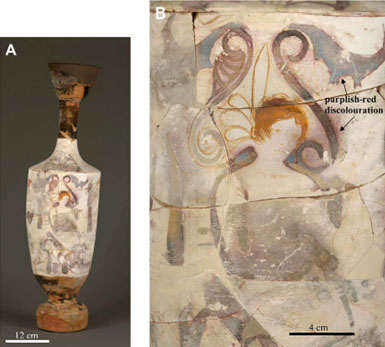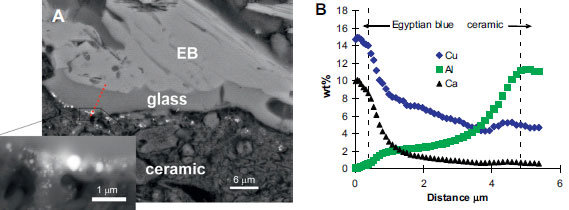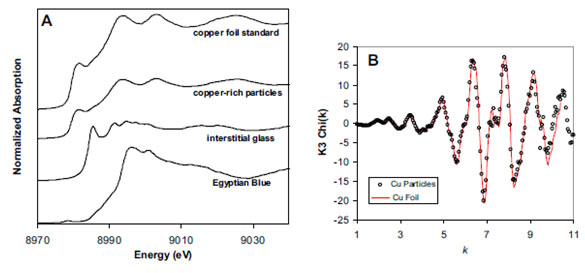

Funeral practices are accorded high significance in most societies and understanding them hold a key to a much deeper understanding of how those societies functioned. These practices tell us how people from centuries past viewed death and after-life, and therefore give us a glimpse into their existential beliefs. The objects associated in these rituals say something about how they lived and what they valued. Furthermore, because of the importance of these rituals in most societies, the objects involved in them have a much higher chance of survival and are often the only material evidence we have of a culture, a society or a civilization.
 | |
Fig. 1 (A) Greek white-ground lekythos from the Antikensammlung Staatliche Museen zu Berlin (F 2683) showing purplish-red discolouration. (B) Detail showing purplish-red. | |
Material evidence for this determination comes from a first systematic chemical
and morphological analysis of distinctive purplish-red discolouration that
appears as diffuse fields and isolated spatters of colour on the surface of
many Attic white-ground lekythoi, and often found adjacent to an area painted
by the pigment Egyptian blue. The differential appearance of the discoloration
on adjoining sherds across a break on some vessels (see Fig. 1) implies that
the vessels were broken prior to the formation of this coloured material. The
diffuse and spattered appearance of these purplish-red areas further suggests
it was not an intentional element of design.
Fig. 2
A) SEM backscatter electron image of a cross-section of Egyptian blue (EB) and
underlying copper particles at interface between glass phase and ceramic. Inset
shows high magnification image of copper particles. (B) Quantitative electron
microprobe line scans of Cu, Al, and Ca starting from the EB (D ¼ 0 mm) and
terminating in the ceramic (D ¼ 5 mm).
Minute cross-sections were taken from two Lekythoi via a technique perfected
for sampling materials from sensitive museum quality objects. The composition
and morphology of the purplish-red discolouration was investigated first by
electron probe microanalysis (EPMA) and scanning electron microscopy (SEM).
Fig 2A, shows a representative cross-section taken from a purplish-red area
with overlying Egyptian blue (EB) pigment. There is a thin glass layer
sandwiched between the stacked lathes of EB and the ceramic, but significant
features in this image are the small, spherical, high Z-contrast nanoparticles
lying at and just below the glass/ceramic slip interface, determined by EPMA to
be copper-rich. Fig. 2B shows the concentrations of Ca, Al and Cu, the
elements that demonstrate the most significant variations, as a function of
position. The concentrations of both Cu and Ca are highest in the EB and
gradually decrease across the glass layer. The bump in Cu content near the
glass-ceramic slip interface corresponds to the location of the Cu-rich
particle. By contrast, the Al profile exhibits the opposite trend: the lowest
concentration is found in the EB, with a gradual increase across the glass
layer, with the highest concentration found in the ceramic slip. These data
indicate a bi-directional diffusion: diffusion of Al out of the ceramic layer
and counter-diffusion of Ca and Cu from the EB particle into the ceramic matrix
underneath. These counter diffusion profiles indicate that the Al rich
white-ground vessels overpainted with EB and other pigments were subjected to
prolonged exposure to high temperature. The Micro x-ray absorption near edge
structure (XANES) , shown in Fig 3A, spectroscopy along a similar depth profile
indicates that the oxidation state of Cu reduces from +2 to metallic as it
diffuse out from EB into Cu rich precipitates just below the surface of the Al
rich ceramic. The XANES depth profile, therefore, indicates that not only
these vessels were cooked at high temperatures after overpainting, but they
were cooked in reducing atmosphere. Extended x-ray absorption fine structure
(EXAFS) spectra taken from the Cu-rich nanoparticles, further indicate that
these reduced Cu particles are metallic Cu in nature. Light absorption at the
surface Plasmon excitation in these metallic Cu nanoparticles gives rise to the
purplish discoloration.
Fig. 3
(A) Cu K-edge XANES spectra of the Cu foil standard, Cu-rich particles, glass
layer, and EB from the cross-section shown in Fig. 2. (B) EXAFS spectrum of Cu
particle (open circles) compared to Cu foil demonstrating that copper particles
have a bulk metallic structure.
The purplish discoloration and uneven coverage over breaks is then a clear
signature that these vessels were thrown into a high temperature reducing fire,
such as a smoky funeral pyre. And an understanding the origin of the
discoloration on these vessels provides the first material evidence that fine
ceramics including white-ground lekythoi, typically associated with banquet
service, were deliberately broken and then burned as part of a cremation
ceremony.
Unfortunately, the majority of lekythoi in museum collections were not
archaeologically excavated under controlled conditions, and thus any direct
link associating them with a funeral ritual has been lost. However, the
evidence presented here provides a new means by which this class of ceramic may
be directly linked with the cremation process, thereby enabling archaeologists
and art historians to confidently include a much a larger number of these
objects in their analysis, which in turn has the potential to dramatically
change our understanding of Athenian funerary ritual.
Primary Citation
M. S. Walton, M. Svoboda, A. Mehta, S. Webb and K. Trentelman, "Material
Evidence for the Use of Attic White-ground Lekythoi Ceramics in Cremation
Burials", J. Archaeol. Sci. 37, 936 (2010)
doi: 10.1016/j.jas.2009.11.026


SSRL is supported by the Department of Energy, Office of Basic Energy Sciences. The SSRL Structural Molecular Biology Program is supported by the Department of Energy, Office of Biological and Environmental Research, and by the National Institutes of Health, National Center for Research Resources, Biomedical Technology Program, and the National Institute of General Medical Sciences.